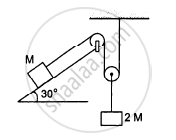Advertisements
Advertisements
प्रश्न
What do you mean by the conservation of momentum? Briefly, explain the collision between two bodies and the conservation of momentum.
उत्तर
Conservation of momentum in case of a collision between two bodies means the total momentum before and after collision remains unchanged or conserved, provided no net force acts on the system.
Consider two bodies A and 8 having masses m1 and m, and initial velocities u1 and u, respectively. The bodies collide head on with each other and their collision lasts for t seconds. Suppose the velocities of A and 8 after collision are v1 and v, respectively. Assume that no external forces are acting on the bodies.
Rate of change of momentum of ball A = m1(v1 - u1)/t .
Rate of change of momentum of ball 8 = m1 (v1 - u1)/t .
If FAB is the force exerted by A on 8 and FBA is the force ex
Rated by 8 on A, we can write
FAB= m1(v1 - u1)/t .
FBA = m1 (v1 - u1)/t .
FAB = -FBA
m1(v1 - u1)/t = - m2(v2- u2)/t .
m1(v1 - u1) = - m2(v2- u2)
m1v1 +m2v2 = m1u1+m2u2
So total momentum after collision = total momentum before collision.
This proves conservation of momentum during collision.
APPEARS IN
संबंधित प्रश्न
A constant retarding force of 50 N is applied to a body of mass 20 kg moving initially with a speed of 15 ms–1. How long does the body take to stop?
A person says that he measured the acceleration of a particle to be non-zero even though no force was acting on the particle.
A force \[\vec{F} = \vec{v} \times \vec{A}\] is exerted on a particle in addition to the force of gravity, where \[\vec{v}\] is the velocity of the particle and \[\vec{A}\] is a constant vector in the horizontal direction. With what minimum speed, a particle of mass m be projected so that it continues to move without being defelected and with a constant velocity?
In the previous problem, suppose m2 = 2.0 kg and m3 = 3.0 kg. What should be the mass m, so that it remains at rest?
Find the acceleration of the block of mass M in the situation shown in the following figure. All the surfaces are frictionless and the pulleys and the string are light.

In the following figure shows a man of mass 60 kg standing on a light weighing machine kept in a box of mass 30 kg. The box is hanging from a pulley fixed to the ceiling by a light rope, the other end of which is held by the man himself. If the man manages to keep the box at rest, what is the weight recorded on the machine? What force should he exert on the rope to record his correct weight on the machine?

Two balls A and B of masses m and 2 m are in motion with velocities 2v and v, respectively. Compare:
(i) Their inertia.
(ii) Their momentum.
(iii) The force needed to stop them in the same time.
A motorcycle of mass 100 kg is running at 10 ms−1. If its engine develops an extra linear momentum of 2000 Ns, calculate the new velocity of a motorcycle.
ame the law of motion which gives the definition of force.
The motion of a particle of mass m is given by x = 0 for t < 0 s, x(t) = A sin 4 pt for 0 < t < (1/4) s (A > o), and x = 0 for t > (1/4) s. Which of the following statements is true?
- The force at t = (1/8) s on the particle is – 16π2 Am.
- The particle is acted upon by on impulse of magnitude 4π2 A m at t = 0 s and t = (1/4) s.
- The particle is not acted upon by any force.
- The particle is not acted upon by a constant force.
- There is no impulse acting on the particle.
